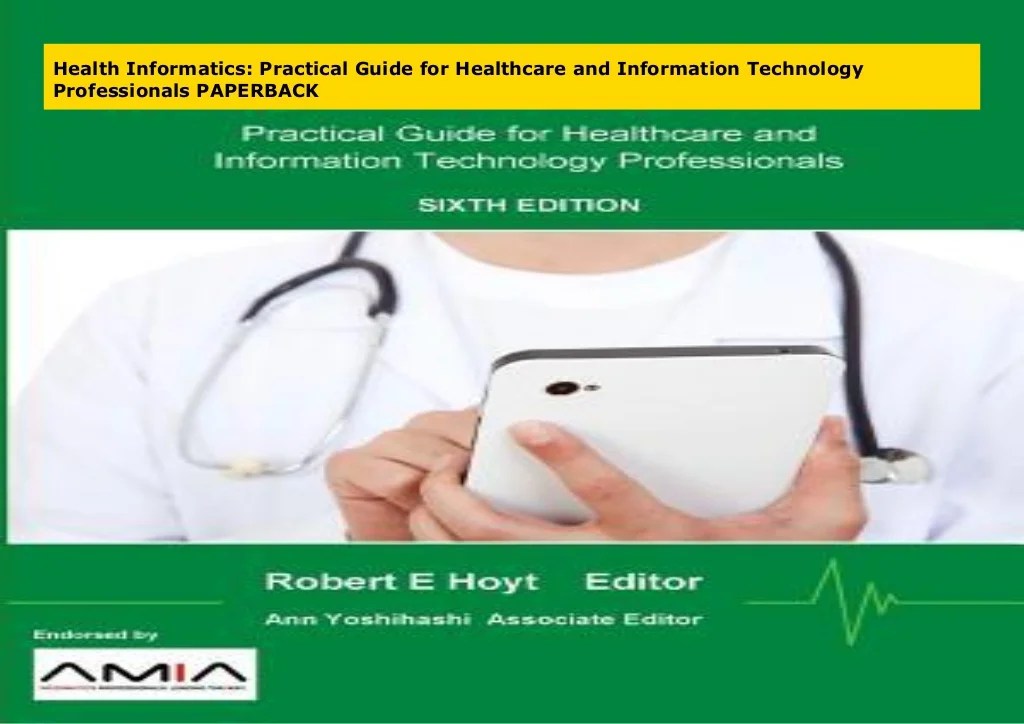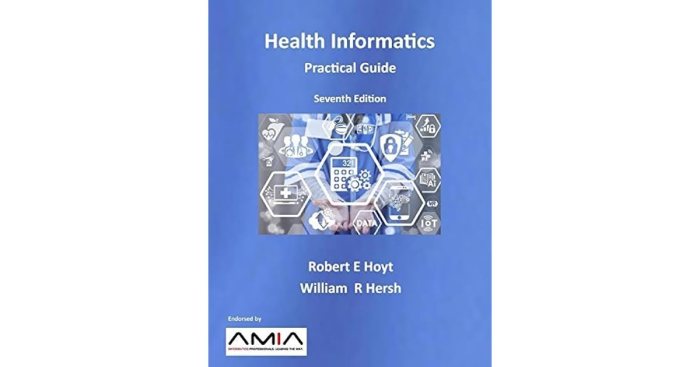Health informatics practical guide 8th edition – Embark on an in-depth exploration of health informatics with the latest edition of the renowned “Health Informatics Practical Guide.” This authoritative resource provides a comprehensive overview of the field, empowering healthcare professionals and students to harness the power of technology for improved patient outcomes.
Delving into the core concepts and applications of health informatics, this guide equips readers with the knowledge and skills to navigate the ever-evolving landscape of healthcare.
Introduction to Health Informatics
Health informatics is the application of information technology to healthcare. It encompasses the use of computers, software, and other technologies to improve the delivery of healthcare services. Health informatics plays a vital role in improving patient outcomes and healthcare delivery by providing clinicians with access to timely and accurate information, enabling them to make better decisions about patient care.
Examples of how health informatics is used in practice include electronic health records (EHRs), which store patient medical information in a digital format; clinical decision support systems (CDSSs), which provide clinicians with information and recommendations to help them make better decisions about patient care; and telehealth, which allows clinicians to provide care to patients remotely.
Data Management and Analytics
Data management is the process of collecting, storing, and managing data. In health informatics, data management is essential for ensuring that patient data is accurate, complete, and accessible. Data analytics is the process of using data to identify patterns and trends.
In health informatics, data analytics is used to improve patient care and healthcare operations by identifying trends in patient data, such as the incidence of certain diseases or the effectiveness of different treatments.
Examples of how data analytics is used to improve patient care and healthcare operations include:
- Predicting the risk of developing a disease
- Identifying patients who are at risk of readmission to the hospital
- Evaluating the effectiveness of different treatments
Clinical Decision Support Systems
Clinical decision support systems (CDSSs) are computer systems that provide clinicians with information and recommendations to help them make better decisions about patient care. CDSSs can be used to provide clinicians with information about a patient’s medical history, current medications, and laboratory results.
They can also be used to provide clinicians with recommendations for treatment, such as the recommended dosage of a medication or the appropriate course of treatment for a particular disease.
Examples of how CDSSs can improve clinical decision-making and patient outcomes include:
- Reducing the risk of medication errors
- Improving the accuracy of diagnoses
- Increasing the adherence to clinical guidelines
Electronic Health Records (EHRs)

Electronic health records (EHRs) are digital versions of a patient’s medical record. EHRs contain a patient’s medical history, current medications, laboratory results, and other relevant information. EHRs can be used to improve patient care by providing clinicians with easy access to a patient’s medical information, regardless of where the patient is located.
EHRs can also be used to improve healthcare efficiency by reducing the need for duplicate testing and by streamlining the process of care.
Examples of how EHRs are used to improve patient care and healthcare efficiency include:
- Improving the coordination of care between different providers
- Reducing the risk of medical errors
- Increasing the efficiency of healthcare delivery
Telehealth and Remote Patient Monitoring: Health Informatics Practical Guide 8th Edition

Telehealth is the use of technology to provide healthcare services remotely. Telehealth can be used to provide patients with access to care from anywhere, regardless of their location. Remote patient monitoring is the use of technology to monitor a patient’s health status remotely.
Remote patient monitoring can be used to identify patients who are at risk of developing a health problem or who need additional care.
Examples of how telehealth and remote patient monitoring can improve access to healthcare and patient outcomes include:
- Providing care to patients in rural or underserved areas
- Improving the coordination of care between different providers
- Reducing the risk of hospital readmissions
Health Information Exchange
Health information exchange (HIE) is the electronic sharing of health information between different healthcare providers. HIE can improve patient care by providing clinicians with access to a patient’s medical information from all of their providers. HIE can also improve healthcare efficiency by reducing the need for duplicate testing and by streamlining the process of care.
Examples of how HIE can improve patient care and healthcare coordination include:
- Improving the coordination of care between different providers
- Reducing the risk of medical errors
- Increasing the efficiency of healthcare delivery
Emerging Technologies in Health Informatics

Emerging technologies in health informatics include artificial intelligence (AI), machine learning (ML), and blockchain. AI is the ability of computers to perform tasks that typically require human intelligence. ML is a type of AI that allows computers to learn from data without being explicitly programmed.
Blockchain is a distributed ledger technology that can be used to create a secure and transparent record of transactions.
Examples of how these technologies are being used to improve patient care and healthcare delivery include:
- Using AI to develop new drugs and treatments
- Using ML to identify patients who are at risk of developing a disease
- Using blockchain to create a secure and transparent record of patient medical information
Ethical and Legal Considerations in Health Informatics
The use of health informatics raises a number of ethical and legal issues. These issues include the privacy and security of patient data, the informed consent of patients, and the liability of healthcare providers for the use of health informatics systems.
Examples of how ethical and legal considerations can impact the implementation and use of health informatics systems include:
- The need to obtain informed consent from patients before using their data for research or other purposes
- The need to protect the privacy and security of patient data
- The potential liability of healthcare providers for the use of health informatics systems
Popular Questions
What are the key benefits of using EHRs in healthcare?
EHRs offer numerous benefits, including improved patient care coordination, reduced medical errors, enhanced patient engagement, and streamlined healthcare operations.
How can telehealth and remote patient monitoring improve access to healthcare?
Telehealth and remote patient monitoring enable healthcare providers to reach patients in remote areas or with limited mobility, expanding access to care and improving health outcomes.
What are the ethical considerations related to health informatics?
Health informatics raises important ethical issues, such as patient privacy, data security, and the potential for bias in algorithms. It is crucial to address these considerations to ensure the responsible and ethical use of health data.